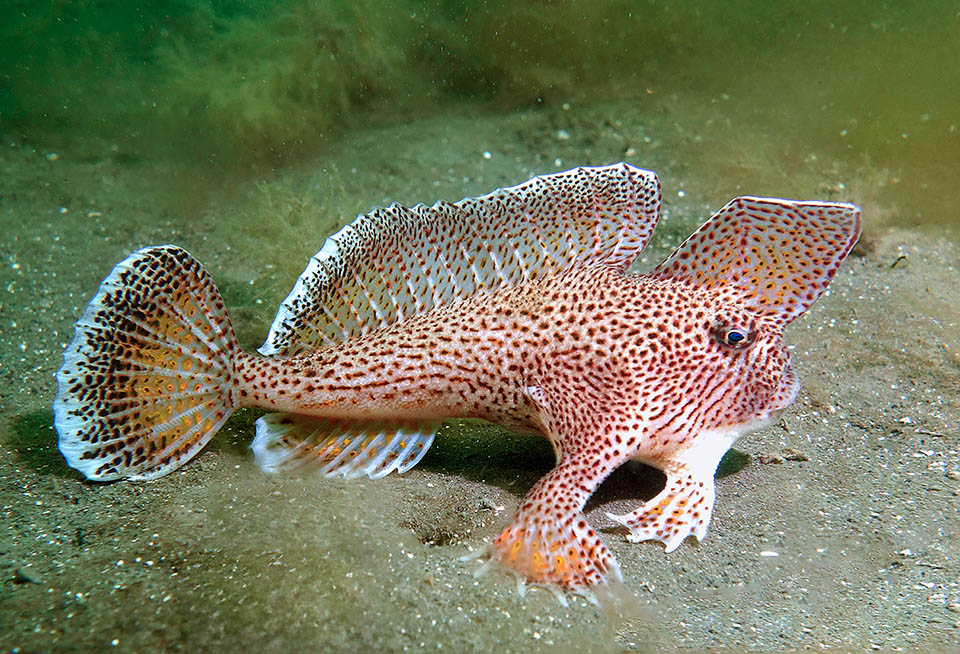Family : Brachionichthyidae

Text © Giuseppe Mazza

English translation by Mario Beltramini

The Spotted handfish (Brachionichthys hirsutus) is a benthic species under extinction risk present only in Tasmania, in river Derwent estuary © John Turnbull
Known as Spotted handfish, Brachionichthys hirsutus (Lacépède, 1804), belongs to the class of the Actinopterygii, the ray-finned fish, and to the order of the Lophiiformes.
They are animals that were circulating already at the beginning of the Tertiary, characterized by a fishing line on the head to attract the curious prey and swallow them in one bite. They are found in all seas, up to over 1000 m deep, with dimensions varying 3 cm to 2 m of the famous Anglerfish (Lophius piscatorius), that, thanks to the goodness of its flesh, and the size, has given the name to the order, presently rich of 18 families, 85 genera and more than 300 species.
Some, like, for instance, Antennarius pictus, have the pectoral fins transformed into legs, Ogcocephalus nasutus has a strange rhinoceros horn, and the illicium of Ogcocephalus radiatus is so short that the preys must practically get in its mouth.

15 cm long at most, has the pectoral fins transformed in arms with a sort of a hand with 7 fingers for moving and digging on seabeds, usually between 5 and 15 m of depth © John Turnbull
The masters in camouflage are not missing, like Antennarius commerson who may take on after a certain time, depending on the environment, whatever colour perfectly imitating the sponges.
Brachionichthys hirsutus, inserted in the family of the Brachionichthyidae that includes 5 genera and 14 species, distinguishes for having the pectoral fins transformed in hands having usually 7 rays similar to fingers.
The name of the genus Brachionichthys, created by Bleeker in 1854, originates composed by the Latin “brachium”, arm, with allusion to the fin transformed in arm, and from the Greek “ichthys”, fish The specific term hirsutus, hispid, spiny in Latin, assigned by Lacépède in 1804, conversely refers to the skin covered by tiny blackish thorns.

It feeds on polychaetes and tiny crustaceans, mainly amphipods and like all Lophiiformes has its illicium on the head, a thin bait to attract the prey © Matty Testoni
Zoogeography
Brachionichthys hirsutus has an extremely reduced range, restricted to the estuary of the river Derwent, in Tasmania, and surrounding areas.
Ecology-Habitat
The Spotted handfish is a demersal non-migratory species that may reach the depth of 60 m, even if usually it is found between 5 and 15 m, and at times even in 1 m of water, preferring the sandy bottoms, rich in shells, and temperatures between 13,5 and 21,2 °C.
Morphophysiology

Females survey for 7-8 weeks, until hatching, 80-250 eggs united in gelatinous masses stuck to vertical supports like ascidians, sponges or vegetables © Keith Martin-Smit
Brachionichthys hirsutus can reach the length of 15 cm. The body is protected by dense semicircular non-imbricated scales with spinules having various lengths starting from the base.
There are two dorsal fins. The first, located on the head like a crest, at times waving to attract the attention of the prey, is followed by a second one, longer. Totally, they have 19-21 soft rays,whilst the anal counts 8-10 of them.
The illicium, particularly thin, has a small bait at the top.
The caudal fin displays, especially in the juveniles, a dense cover of small dots forming a dark submarginal bar, whilst the rest of the body is adorned with more spaced dots and streaks.

At birth the offspring are already perfectly formed. They measure 6-7 mm and disperse on the seabed © Matty Testoni
Ethology-Reproductive Biology
Brachionichthys hirsutus feeds on polychaetes and on small benthic crustaceans, mainly amphipods.
Reproduction occurs between September and October.
The females, who reach sexual maturity when 2-3 years old, when about 7,5-8 cm long, often have difficulties in finding a male due to the poor mobility of the species. They lay 80-250 3-4 mm eggs united in gelatinous masses that they stick on vertical supports like pedunculated ascidians, sponges, grasses and weeds.
The female surveys the brood for 7-8 weeks, until hatching, when already perfectly formed 6-7 mm juveniles come to life.

Once common, Brachionichthys hirsutus is now threatened, pollution apart, by Asterias amurensis, alien starfish coming from northern Pacific © Matty Testoni
The resilience is not known and the fishing vulnerability, very low, marks only 10 on a scale of 100. However, since 2018, Brachionichthys hirsutus appears as “CR, Critically Endangered”, in the IUCN Red List of the endangered species.
Once it was common in Tasmania, but starting from the ’90 years the species has suffered the attack of Asterias amurensis, a starfish coming from the North Pacific who preys its eggs and devours the ascidians, their choice support for the nest.
Added to this has appeared the pollution of the low estuary of the Dewent contaminated by heavy metals due to the port and industrial activities.
Synonyms
Lophius hirsutus Lacépède, 1804.
→ For general information about FISH please click here.
→ For general information about BONY FISH please click here
→ For general information about CARTILAGINOUS FISH please click here.
→ To appreciate the BIODIVERSITY of BONY FISH please click here.
→ To appreciate the BIODIVERSITY of CARTILAGINOUS FISH please click here.
